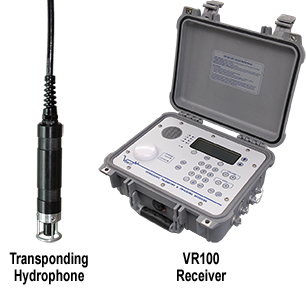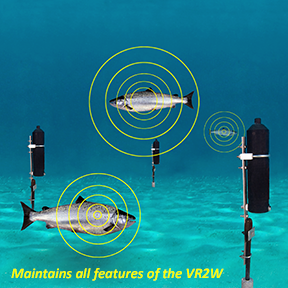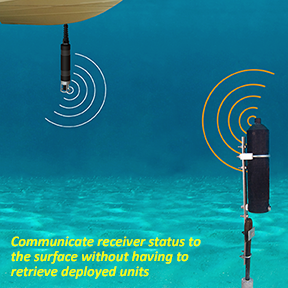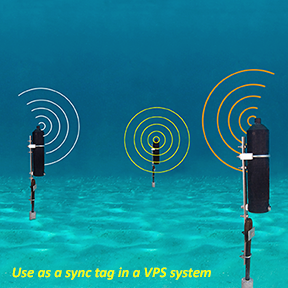VR2Tx : Transmitting Receiver
-
Overview
The VR2Tx Acoustic Receiver combines a VR2W receiver with a built in V16-like transmitter that allows communications with receivers while still deployed.
The VR2Tx maintains all of the existing features of the VR2W receiver plus much more.
- Improve VPS (fine scale positioning) results using the built in transmitter as a VPS sync tag
- Retrieve receiver status on demand from the surface via communications with a VR100 tracking receiver (models -200 and greater) and transponding hydrophone (VR100 and hydrophone sold separately)
- monitor health, tilt angle, range, temperature, battery life and memory of deployed VR2Tx units
- monitor number of total detections as well as specific tag IDs with the programmable watch table
- determine which receivers are in range of the VR100 (unit discovery mode)
- locate potentially lost VR2Tx units
Surface to Receiver Communications Using the VR100 Receiver
The VR2Tx communicates to the surface using the VR100 active tracking receiver with a transponding hydrophone and is compatible with all VR100 models sold since January 2013. Customers will require a new transponding hydrophone to attach to the VR100 to communicate with the VR2Tx.Communicating with Your Receivers
A Bluetooth-enabled laptop or PC is required to communicate with your receivers.Operating Systems
VUE requires VISTA, Windows 7, 8 and 10 operating systems.For more details, see Downloads section.
Have you looked whether you need to update your VR2s? click here
-
Gallery





-
Frequently Asked Questions
How much detection range can I expect from my tags and receivers?
Are VEMCO receivers and tags compatible with another company’s receiver and/or tags?
How long will my VR2Tx battery last?
Can I convert my 69kHz VR2Tx receiver into a 180 kHz receiver?
Does receiver orientation matter?
At low tide my VR2Tx receiver will be exposed to direct sunlight. Does this matter?
My VR2Tx has detected ID’s that do not belong to me. What should I do?
I cannot connect to my VR2Tx receiver. What should I do?
Can my VR2Tx measure noise in a specific location?
How much detection range can I expect from my tags and receivers?
Detection range depends on so many factors that it is difficult to estimate without knowledge of the environment and prior experience with telemetry. Range depends on transmission power, signal absorption, line of sight, reflection/refraction, multipath and environmental noise (man-made & natural), and the receiving quality of the receiver/hydrophone. Typically areas that have clear water, sand or silt flat bottoms and low current exhibit the greatest ranges. Conversely, areas with turbid water, complex rocky bottom topography and high current exhibit low ranges. In all cases, extreme weather events and periods of high wind (waves) may significantly reduce range.
In most cases, greater transmission power output (dB) results in greater range. For example, in good conditions a V7-VR2Tx range test could yield a range of 300-400 m and a V16-VR2Tx test could yield ranges of 800-1200 m. There are some exceptions where high power and a reflective and low noise environment may cause detection breakdowns. The VR2Tx has a V16-like transmitter built-in which has all the power output setting options as the V16.
Please try our Range Calculator but only use the results as a guide. One should always perform range testing to determine appropriate receiver spacing. For the enthusiast who wants to learn more about sound propagation, try the widely accepted reference on underwater sound by Urick (1983). (Urick, Robert J. Principles of Underwater Sound, 3rd Edition. New York. McGraw-Hill, 1983.).
Are VEMCO receivers and tags compatible with another company’s receiver and/or tags?
No, our receivers and coded transmitters are not compatible with other vendor’s equipment. Our receivers and transmitters are designed to work as a system using the VEMCO proprietary coding system. Some manufacturers make claims of compatibility but these are false. Over time, we change code maps and tag and receiver firmware and hardware to enhance both functionality and coding options to allow you to conduct research and data analysis with confidence. We cannot provide support for data analysis (e.g., VPS, false detect analysis, biological analysis) for any data that might originate from competitor tags or receivers.
How long will my VR2Tx battery last?
VR2W receivers are to be used with a Tadiran TL-5930/F Lithium Inorganic 3.6V battery or equivalent. These batteries will last approximately 12-15 months in a 69 kHz receiver and 8-10 months in a 180 kHz receiver. Frequent communication via Bluetooth and your PC will consume more battery life than when the receiver is in RECORD mode.
You cannot rely on the battery voltage in VUE as an indicator of remaining life due to the discharge characteristics of this battery type. To ensure you are always using a battery with enough remaining life, we recommend tracking actual time the battery has been in use by writing deployment/retrieval dates directly on the battery. Inspect the battery case prior to deployment and do not use if there is any damage.
These batteries have a shelf life of approximately 5 years. Store these batteries at room temperature and always disconnect the battery in the VR2W if you plan on storing your receivers for any long periods (i.e. months at a time).
For information on how to change your receiver’s battery, please refer to Section 2 of the VR2W User Manual (see Downloads Section)
You may ask our sale consultant about alternative battery options.
Can I convert my 69kHz VR2Tx receiver into a 180 kHz receiver?
No, a 180 kHz version of the VR2Tx receiver is not yet available.
Does receiver orientation matter?
Generally, in most cases we recommend that a VR2Tx should be orientated with the hydrophone looking upwards. This is typically because receivers are commonly moored closer to the seafloor than the surface. In some situations it may be beneficial to mount the receiver with the hydrophone pointing towards the sea floor. If a receiver is mounted near the surface or a considerable distance from the sea floor and if the researcher is monitoring benthic creatures a bottom looking receiver may perform better because your tagged animals will not be in a shadow zone (under the receiver). If receiver orientation is a concern, we recommend that you perform range tests.
Note that the tilt angle of a deployed VR2Tx can be checked remotely using a VR100.
At low tide my VR2Tx receiver will be exposed to direct sunlight. Does this matter?
The VR2Tx has a recommended operating temperature range of -5 to 40oC. If there is a possibility that your receiver will exceed either of these temperatures, please consider another deployment location. Exposure to direct sunlight can cause the internal temperature of the black receiver case to reach temperatures much higher than the ambient temperature.
My VR2Tx has detected ID’s that do not belong to me. What should I do?
We would be very pleased to help connect with the owners of these unknown IDs. VEMCO Customer Service section contains detailed information on our procedure for addressing the detection of foreign/unknown IDs.
I cannot connect to my VR2Tx receiver. What should I do?
If you are having trouble connecting to a receiver via Bluetooth first ensure that you are using the VUE Preview Beta Software Version of VUE Software for the VR2Tx and VR2AR and refer to the Bluetooth Troubleshooting Quick Guide.
Can my VR2Tx measure noise in a specific location?
Yes. VEMCO’s VR2Tx receiver has the ability to record average noise levels as well as min/max noise levels for a specified time period. If noise logging reveals that a deployment location may be unsuitable, then a comparison of noise levels at other deployment locations can be performed, and the least noisy location can be chosen. Also, the VR100-200 surface unit with a VHTx (Transponding Hydrophone) can be used to request and display noise measurements without having to retrieve your receiver. For more information, see the VR2AR & VR2Tx Receiver Noise Measurement Guide.
-
Specifications
Specifications Dimensions 308 mm long x 73 mm diameter Weight 1190 g in air, 50 g in water Power supply 1 – 3.6 V Lithium D cell battery Battery life Approximately 14 months Maximum depth 500 metres Receive frequency 69 kHz standard Storage Approximately 3-million detections (32 MBytes non-volatile flash memory) Communication Acoustic via VR100 and Bluetooth® Attachment Standard: cable ties Firmware Field upgradable receiver firmware Software VEMCO user Environment (VUE) software Transmitters Logs and decodes ALL Vemco 69 kHz transmitters Code maps Support for all current and planned VEMCO code maps -
Downloads